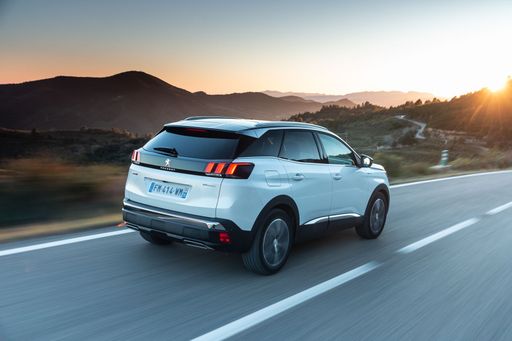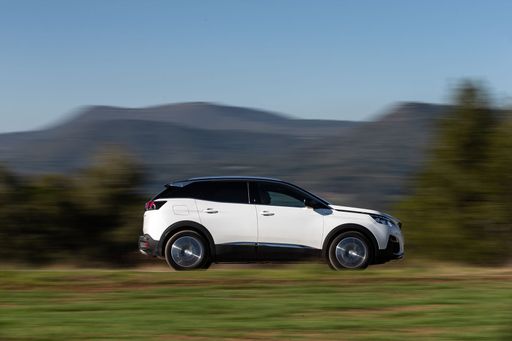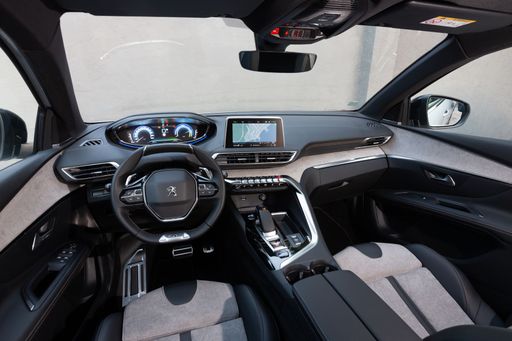Peugeot 3008 vs Renault R4 – Differences & prices compared
Compare performance, boot space, consumption and price in one view.
Find out now: which car is the better choice for you – Peugeot 3008 or Renault R4?
The Peugeot 3008 (SUV) comes with a Plugin Hybrid, Electric or Petrol MHEV engine and Automatic transmission. In comparison, the Renault R4 (SUV) features a Electric engine with Automatic transmission.
When it comes to boot capacity, the Peugeot 3008 offers 520 L, while the Renault R4 provides 420 L – depending on how much space you need. If you’re looking for more power, decide whether the 325 HP of the Peugeot 3008 or the 150 HP of the Renault R4 suits your needs better.
In terms of consumption, the values are 16.90 kWh0.90 L per 100 km for the Peugeot 3008, and 14.20 kWh for the Renault R4.
Price-wise, the Peugeot 3008 starts at 35100 £, while the Renault R4 is available from 25200 £. Compare all the details and find out which model fits your lifestyle best!
Peugeot 3008
The Peugeot 3008 is a compact SUV that seamlessly combines sleek design with modern functionality. Its interior offers a sophisticated and comfortable driving experience, characterised by high-quality materials and innovative technology features. With its dynamic performance and stylish aesthetics, the 3008 stands out in the competitive world of family SUVs.
details @ media.stellantis.com
@ media.stellantis.com
 @ media.stellantis.com
@ media.stellantis.com
 @ media.stellantis.com
@ media.stellantis.com
 @ media.stellantis.com
@ media.stellantis.com
Renault R4
The Renault R4, affectionately known as the "R4," is a quintessential symbol of French automotive simplicity and practicality. This classic compact car, originally introduced in the early 1960s, won over numerous enthusiasts with its versatile design and dependable performance. Its no-frills charm and robust build made it a beloved choice for rural drivers and city dwellers alike, cementing its status as an iconic piece of automotive history.
details

|
|
|
|
|
Costs and Consumption |
|
|---|---|
|
Price
35100 - 51400 £
|
Price
25200 - 31200 £
|
|
Consumption L/100km
0.9 - 5.4 L
|
Consumption L/100km
-
|
|
Consumption kWh/100km
16.9 - 17.8 kWh
|
Consumption kWh/100km
14.2 - 15.1 kWh
|
|
Electric Range
85 - 698 km
|
Electric Range
308 - 409 km
|
|
Battery Capacity
0.4 - 96.9 kWh
|
Battery Capacity
40 - 52 kWh
|
|
co2
0 - 121 g/km
|
co2
0 g/km
|
|
Fuel tank capacity
55 L
|
Fuel tank capacity
-
|
Dimensions and Body |
|
|---|---|
|
Body Type
SUV
|
Body Type
SUV
|
|
Seats
5
|
Seats
5
|
|
Doors
5
|
Doors
5
|
|
Curb weight
1648 - 2337 kg
|
Curb weight
1485 - 1537 kg
|
|
Trunk capacity
470 - 520 L
|
Trunk capacity
420 L
|
|
Length
4542 mm
|
Length
4144 mm
|
|
Width
1895 mm
|
Width
1808 mm
|
|
Height
1641 mm
|
Height
1552 mm
|
|
Payload
383 - 467 kg
|
Payload
410 - 443 kg
|
Engine and Performance |
|
|---|---|
|
Engine Type
Plugin Hybrid, Electric, Petrol MHEV
|
Engine Type
Electric
|
|
Transmission
Automatic
|
Transmission
Automatic
|
|
Transmission Detail
Dual-Clutch Automatic, Reduction Gearbox
|
Transmission Detail
Reduction Gearbox
|
|
Drive Type
Front-Wheel Drive, All-Wheel Drive
|
Drive Type
Front-Wheel Drive
|
|
Power HP
145 - 325 HP
|
Power HP
122 - 150 HP
|
|
Acceleration 0-100km/h
6 - 10.2 s
|
Acceleration 0-100km/h
8.2 - 9.2 s
|
|
Max Speed
170 - 220 km/h
|
Max Speed
150 km/h
|
|
Torque
230 - 511 Nm
|
Torque
225 - 245 Nm
|
|
Number of Cylinders
3 - 4
|
Number of Cylinders
-
|
|
Power kW
107 - 239 kW
|
Power kW
90 - 110 kW
|
|
Engine capacity
1199 - 1598 cm3
|
Engine capacity
-
|
General |
|
|---|---|
|
Model Year
2024 - 2025
|
Model Year
2025
|
|
CO2 Efficiency Class
B, A, D
|
CO2 Efficiency Class
A
|
|
Brand
Peugeot
|
Brand
Renault
|
Peugeot 3008
Introduction to the Peugeot 3008
In the rapidly evolving world of SUVs, the Peugeot 3008 stands out as a prime example of innovative design and advanced technology. Offering a range of powertrains from hybrid to fully electric, the 3008 is tailored to meet the needs of eco-conscious drivers without sacrificing performance or luxury.
Powertrain Options and Performance
The Peugeot 3008 is designed to cater to a variety of driving preferences with its versatile range of powertrains. The options include petrol mild-hybrid, plug-in hybrid, and full electric variants. The power output ranges from a modest 136 PS to a robust 210 PS, providing a performance spectrum to suit both city commuters and long-distance travellers. Notably, the plug-in hybrid variant boasts an impressive electric range of up to 85 km, while the electric version can travel up to 524 km on a single charge, making it ideal for both urban and rural settings.
Driving Dynamics and Efficiency
The 3008's driving dynamics are refined and engaging, supported by its front-wheel-drive configuration and automatic transmission. Depending on the model, the vehicle can accelerate from 0 to 100 km/h in as little as 8.4 seconds, while maintaining an efficient fuel consumption rate of as low as 0.9 L/100km for the plug-in hybrid variant. For the eco-conscious drivers, the electric model offers a consumption rate of 17.7 kWh/100km, and its CO2 emissions range from 0 to 129 g/km, reflecting its commitment to reducing environmental impact.
Design and Comfort
The Peugeot 3008 boasts a modern and sophisticated design that embodies both elegance and functionality. Its expansive interior offers seating for five, complemented by a generous boot capacity of 520 litres. The vehicle's dimensions—4,542 mm in length, 1,895 mm in width, and 1,641 mm in height—ensure ample space and a commanding presence on the road. Additionally, the 3008's array of equipment lines like Allure and GT enhance the driving experience with premium features and luxurious touches.
Innovations and Technology
The Peugeot 3008 is equipped with a suite of cutting-edge technological features designed to enhance the driving experience. The intuitive infotainment system is central to the vehicle's interior, offering seamless connectivity and navigation options. Safety and driver assistance technologies are also prominent, including advanced systems for collision avoidance and parking assistance, ensuring peace of mind on every journey.
Conclusion
In summary, the Peugeot 3008 is a compelling choice for those seeking a versatile and modern SUV. With a range of efficient powertrains, dynamic performance, and luxurious design elements, it caters to a broad spectrum of drivers. Its advanced technological features and commitment to sustainability make the Peugeot 3008 a forward-thinking option in today's automotive landscape.
Renault R4
The Timeless Charm of the Renault R4: A Journey from Classic to Contemporary
The Renault R4 is an iconic name that echoes through automotive history, its roots deeply entrenched in the legacy of Renault's innovative engineering. As we usher into 2025, the classic appeal of the R4 meets modern innovation with the latest electric versions. Let's explore what makes the Renault R4 a remarkable blend of nostalgia and technology.
A Classic Reinvented: The Renault R4 Specifications
The Renault R4 is primarily an SUV, showcasing its versatility as both a practical family car and an adventurous road companion. The latest model comes with the robustness and aesthetic appeal we've come to expect from Renault, enhanced by cutting-edge electric powertrains.
Designed as an electric vehicle, the new Renault R4 variations come with different battery capacities ranging from 40 kWh to 52 kWh. These provide impressive ranges of up to 322 kilometers and 409 kilometers, catering to both urban and suburban travel needs. The power output ranges from a respectable 122 HP to a more robust 150 HP, ensuring a dynamic driving experience.
Performance Meets Innovation
The Renault R4 is equipped with front-wheel drive and automatic transmission, offering smooth and efficient performance. Speed enthusiasts will appreciate the acceleration from 0 to 100 km/h in just 8.2 to 9.2 seconds, while adhering to a maximum speed of 150 km/h. Torque figures range from 225 Nm to 245 Nm, ensuring responsive handling and robust performance on various terrains.
Weighing between 1485 kg and 1537 kg, the R4 balances weight and power adeptly. It boasts a trunk capacity of 420 liters, catering to family trips, weekend getaways, or simple grocery runs with ease. The modern design accommodates five passengers comfortably, with ample space and quality interiors.
Sustainable Future: The Eco-Friendly Appeal
Reducing carbon footprints is a significant feature of the new Renault R4, which stands proudly with a CO2 emission rate of 0 g/km, placing it in the A class for CO2 efficiency. This marks a step towards achieving environmentally-friendly transportation without compromising the significant power and performance expected from a traditional SUV.
Comfort and Utility: Perfect for Modern Lifestyles
Renault has crafted the R4 to suit the needs of the modern driver, focusing on comfort, utility, and sustainability. It measures 4144 mm in length, 1808 mm in width, and 1552 mm in height, perfect for navigating both city streets and open highways. The payload capacity ranges between 410 kg and 443 kg, demonstrating its capacity for carrying both people and cargo efficiently.
Conclusion: The Renault R4 Legacy Continues
The Renault R4 continues to be a symbol of innovation and practicality. Its evolution from past to present-day models features a brilliant synthesis of nostalgic allure and state-of-the-art technology. With its recent models, the R4 not only preserves its iconic status but also sets new standards for electric SUVs in the modern market. As we look forward, the Renault R4 remains a cherished companion on the roads, echoing the spirit of exploration and sustainability.
What drivetrain options does the Peugeot 3008 have?
Available configurations include Front-Wheel Drive or All-Wheel Drive.
The prices and data displayed are estimates based on German list prices and may vary by country. This information is not legally binding.
